The Kingdom of Cambodia went through many difficult periods in its history. In spite of everything, everywhere are smiling faces. In the ancient temples of Angkor, in the sculptures, even Pol Pot smiles in a few surviving photos.
|
The Kingdom of Cambodia is a country located in the Indochina Peninsula in Southeast Asia, bordered by Vietnam, Laos and Thailand. Phnom Penh is the capital, while Battambang, Siem Reap and Sihanoukville are other big cities. The Mekong River is the country’s backbone that has nurtured Cambodians for centuries. Most of the country's population has Khmer origin and Khmer language is the official one. Buddhism is a major religion.
Cambodia descends from the glory of the great Angkor Empire, which flourished between XI and XIII centuries. It was during this period that the magnificent city of Angkor was built. Some people say that in its peak moment, the city had more than one million inhabitants. At the end of the XIX century, the country became a part of the French Indochina. King Sihanouk proclaimed the independence in 1953 and soon after started to rebuild the country. Although he was very egoist, Sihanouk was treated as a semi divine person by peasants. He modernized Cambodia, building roads and many other public buildings (as the National Stadium in Phnom Penh). However, this was the last bright moment in the country’s history. Cambodia was involved in the Vietnam War (some say that secret bombings killed more than 250,000 people), after which the Khmer Rouge took the power. This is one of the darkest cards in human history, as Pol Pot regime annihilated more than one and a half million of its citizens. Their cruelty had no explanation and the tortures were never judged. Even now, they enjoy a better life than their victims do. The Khmer Rouge were driven out by the Vietnamese, but the internal fights finished only around the year 2000.
Travelling around is generally easy. Phnom Penh and Siem Reap have international airports with domestic and international flights. Travellers can get to other parts of the country by buses, pick ups or boats. A major problem and big danger in some parts of the country are hidden mines. If you see the sign, don't leave the path!
|
|
| Favourite spots: |
|
If I could turn back time, I would like to be with Henry Mouhot in 1860, "discovering" the ancient city of Angkor, mostly covered by the jungle. "The temple which is the city" was built during King Suryavarman II’s regime (1113 - 1145). The Khmers upgraded the irrigation systems and their kingdom began to dazzle. Once the nutrition problem had been solved, the Kings turned into the construction of the temples. Angkor Wat was the masterpiece of their efforts. The entire complex is surrounded by a moat. Leaving from the outer walls, a 540 m long road paved with thick, square-cut stones, leads to the outer gallery. Its 800 m long walls are completely covered by the invaluable bas-reliefs ("Churning of the Ocean of Milk" is the most stunning in my opinion). The main temple has two courtyards and the main point is the two level central shrine topped with nine towers. Angkor Wat is the most beautiful during the sunset, when the last rays of sun illuminates the silhouette of the towers.
|
|
| What's really great: |
 |
 |
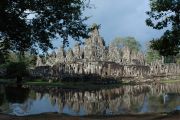 |
 |
 |
 |
 |
 |
Bayon temple in Angkor Thom
 |
 |
After defeating the Chams army, the King Jayavarman VII significantly increased the importance of the Khmer Empire. He built a network of royal roads and linked them all to Angkor Thom, the new capital of the empire. One can still see a lot of preserved constructions within the walls of the ancient capital. The Bayon Temple is the most beautiful one. It is a collection of 54 towers decorated with 216 smiling, enormous faces of Avalokiteshavara. Some historians say that the faces on the Bayon Temple were once gilded with golden leafs. Sometimes, religious ceremonies are still held there. Bayon has three levels of galleries, the lowest containing the most precious bas-reliefs. Other wonders in Angkor Thom include: the Bauphon Temple (that existed before the construction of Angkor Thom and probably was the most stunning temple during its heydays), the Royal Enclosure, the Phimeanakas Temple and the terrace of Elephants (that was the place from where the King inspected its army).
|
|
| Sights: |
 |
 |
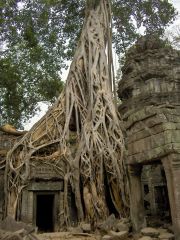 |
 |
 |
 |
 |
 |
Tree roots on the Ta Phrom temple
 |
 |
Ta Phrom is an example of a temple that was discovered in the midst of the jungle, being untouched since it was abandoned. Massive tree roots, like huge serpents, crawl over its roof and walls, testimony to the amazing life force of the jungle. Jayavarman VII built Ta Phrom around the year 1186. The site was home to more than 12,500 people, including 18 high priests and hundreds of dancers. One of the most amazing moments during my visit in Angkor was wandering around the temple.
Other wonderful temples are:
Ta Keo - "The unfinished temple" built in the early XI century, but the construction was stopped after the death of the king. The stone blocks were assembled, although no bas-reliefs were done.
Pre Rup is a pyramid temple and one of the oldest on the site. Built around 961 is a three-storey construction with four towers on the top.
Banteay Srei is a well preserved temple, built in 967 and located near Angkor. The building is covered by decorative and narrative carvings.
|
|
| Accommodations: |
 |
 |
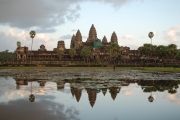 |
 |
 |
 |
 |
 |
Another picture of Angkor Wat
 |
 |
After many years of international isolation (during the Pol Pot regime, there was only one flight every two weeks from Phnom Penh to Beijing), Cambodia became an extremely popular destination in Southeast Asia. International hotel chains recently invaded Siem Reap, due to its proximity to the Angkor temples. Almost all worldwide known chains have their hotels there. However, travellers with less money will not have a problem to find a place to sleep. Many hostels and guesthouses will give a choice for everybody. As Siem Reap is much sprawled, it is wise to check the distance between the hotel and the city centre or the Angkor complex. During my visit in Siem Reap, I stayed in the Dara Reang Sey Hotel (36 USD per double). It was nice, but very far from everything. Many hotels provide other services, like trips to Angkor, hot air balloon rides, transportation to/from the airport and bike rental. In Phnom Penh, Sisowath Quay is the area where the majority of places to sleep are located.
|
|
| Nightlife: |
|
As Angkor is popular with tourists, the way you sightsee is important . You can buy tickets in Angkor for one day (20 USD), three days (40 USD) or for one week (60 USD) - although spending only one day there should be considered a crime :)! In addition, due to the distances between the temples, it is wise to consider means of transportation. Busses are for those who like comfort, motorbikes and rickshaws are for lazy ones or for those with not much time and bicycle can be a great choice for sporty ones. I didn’t meet anybody who would travel between the temples on foot. Most of guidebooks give advice on the order of sightseeing. Try to discover when and where the biggest crowds will come and avoid them! And, the last but not least advice: Angkor Wat is the most stunning during the sunset, Pre Rup gives a great sunset view over the temples and Bayon is astonishing during the sunrise. However, all this is already known to hundreds of other tourists.
|
|
| Hangouts: |
 |
 |
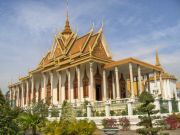 |
 |
 |
 |
 |
 |
The Silver Pagoda in Phnom Penh
 |
 |
17 of April 1975 was the most tragic day in 600 years of history of Phnom Penh. On that same day, the Khmer Rouge forces captured the city and ordered the evacuation of its inhabitants. Two million people abandoned the city in few days. They were allowed to come back only four years later, when the Vietnamese forces defeated Pol Pot.
Until that moment, Phnom Penh was one of the prettiest cities in Asia, often nicknamed "Paris of Asia", with its colonial architecture, wide boulevards and monumental constructions raised on the orders of King Sihanouk. Nowadays Phnom Penh, located on the Mekong river’s banks is again a central point of Cambodia, with more than two million inhabitants.
The city has many attractions to offer. The most important are:
- Wat Phnom, the oldest and tallest pagoda in the city,
- The Royal Palace, built in 1866,
- The National Museum, established in 1920,
- Wat Botum, from 1930,
- The Olympic Stadium,
- The Independence Monument,
- Colonial architecture
|
|
| Restaurants: |
|
Asian cuisine takes its best here. Cambodian cuisine is rich in seafood and fish, thanks to the Gulf of Thailand, the Mekong River and the Tonle Sap Lake (which is one of the biggest freshwater basins in the world and one of the richest in fish). Fish is prepared there with aromatic herbs or marinated citrus. Soups, meat and fishmeals are prepared with garlic, ginger, pepper, lemon grass, chilli and fresh herbs like basil, coriander and mint. Shrimps and squids are very popular seafood. Rice is the principal staple and it is the base of the diet. French also left there their mark and baguette is the most popular bread. In Cambodia, we can also try other "delicacies" like grilled frogs, spiders (similar to tarantula) and crickets. The national beer is "Angkor" - what a surprise :). I asked my travel fellows about their memories: Joanna said that she still remembers the taste of the fresh pineapples. I agree, Cambodia has one of the best fruits in the world (pineapple, mango, coconuts).
|
|
| Other recommendations: |
 |
 |
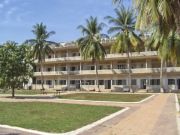 |
 |
 |
 |
 |
 |
Tuol Sleng Genocide Museum
 |
 |
The Tuol Sleng Genocide Museum and the Killing Fields of Choeung Ek are not to be missed. It is very difficult to refer to them as tourist attractions, but it is very important to remember what happened there.
The Khmer Rouge converted the high school complex into "Security Prison 21". Out of more than 17,000 people imprisoned here (exact number remains unknown) only 8 survived. Others were tortured and killed with no mercy. Nowadays, Tuol Sleng is a museum with an emotional exhibition. Hundreds of prisoners pictures are shown, torture tools are on display with detailed descriptions of tortures and cells where the prisoners were kept can be visited. There are even stains of blood in one room.
The Killing Fields of Choeung Ek are the site of a former orchard, about 17 km from Phnom Penh. After the fall of the Khmer Rouge regime, a massive grave with 8,895 bodies was discovered there. It is claimed that the Pol Pot regime killed and buried there more than 17,000 people.
|
|
Published on Thursday April 12th, 2012
|
|
 Publish on Facebook
Publish on Facebook
|
Wed, May 02 2012 - 01:48 PM
 by bootlegga
Fri, Apr 27 2012 - 02:20 AM
 by bineba by bineba
| Loved reading your report. one can really feel how much you enjoyed your visit. Lots of practical info and some great photos! |
Sun, Apr 15 2012 - 12:09 PM
 by pesu by pesu
| Splendid report with brilliant photos! Such great locations and I like the personal way you described both the beauty of the place and the horrible history of the country very much. Thank you, Rafal! |
Fri, Apr 13 2012 - 04:12 AM
 by mistybleu by mistybleu
Rafal,
I thoroughly enjoyed reading your report. This is a great location and you have chosen some stunning pictures to compliment it.
Amanda |
Thu, Apr 12 2012 - 03:11 PM
 by krisek by krisek
| Thank you Rafa? for a very nicely narrated report! Great detail, practical information, background and stunning photos. King Suryavarman's reign is not generally considered as being as bad as a regime, is it? It has been a longer while since I went to see Angkor. I was then genuinely impressed! I have been wondering how things have progressed since 2004... |
Thu, Apr 12 2012 - 01:56 PM
 by el2995 by el2995
| A great report with lots of good background and useful information backed by very nice photos! I wish that the report field sizes could be expanded, as there is so much helpful information and insights that can be conveyed based on a traveler's experiences and it's hard to fit it all into fields of only 1000 to 2000 characters . I thoroughly enjoyed Angkor/Siem Reap and will visit Phnom Penh if I ever return to Cambodia. I hope that Siem Reap doesn't begin to lose its charm too quickly as it becomes more built up to accomodate the growing number of tourists. Cheers! |
| Information: |
| Login if you are a member, or sign up for a free membership to rate this report and to earn globo points! |
|
| Bolivia |
|
|
 |
| Cambodia |
|
|
 |
| Chile |
|
|
 |
| China |
|
|
 |
| Czech Republic |
|
|
 |
| France |
|
|
|
|
|
|
|
|
 |
| Hungary |
|
|
 |
| Lithuania |
|
|
 |
| Macedonia |
|
|
 |
| Portugal |
|
|
|

|
